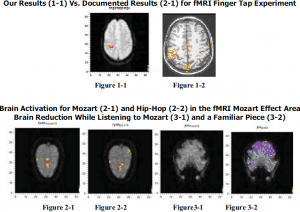Todd Harris and Dr. Travis Oliphant, Electrical Engineering
While it is obvious that hearing a sound produces measurable changes in the brain’s auditory cortex, it is less clear how a compilation of tones, beats, and rhythms affect other areas. In this study I use fMRI to observe which structures in the brain become active in response to music in three male subjects. My results show that different music pieces have unique and measurable affects on the brain. A strong determining factor on the effect that music has is the familiarity of the music to the listener. Results show that familiar music reduces overall brain activity while stimulating a few small distinct areas
Functional Magnetic Resonance Imaging (fMRI) has gained popularity in recent years as an effective way of imaging brain activity under specific stimuli [1]. In this study I used fMRI to observe which structures in the brain become active in response to music in three male subjects. The subjects listened to three different genres of music including hip-hop, classical, and one chosen by the listener. The music piece representing hip-hop is Jay-Z’s “H to the Izzo.” Mozart’s “Eine Kleine Nachtmusic Allegro” represents classical. Each subject selected a third piece of music according familiarity and taste.
To acquire data I used an MRI scanner with a T2* weighted echo-planar pulse sequence. Scans with this pulse sequence highlight areas of the brain in which oxygenated blood is moving or accumulating; this corresponds to areas of the brain that are active. I had subjects listen to 30 seconds of music followed by 30 seconds of silence over a four-minute period. The scanner makes 80 full brain scans in 4 minutes. As a result I acquired 40 scans taken while a subject listened to a music piece (i.e. active) and 40 scans taken while he did not (i.e. baseline).
To process the data I worked with a student, David Thayer, to develop a computer program in Python. This program performs a statistical test to subtract the baseline data from the active data and highlight areas of the brain that increase or decrease in activity under the stimulus. We conducted a preliminary experiment in which we had a subject repeatedly tap his finger while in the MRI. We compared our results with documented results from a similar fMRI project [2] to test that our programs and procedures worked correctly. See figure 1-1 and figure 1-2.
Studies show that listening to Mozart music increases cognitive reasoning, known as the Mozart Effect [3]. Some studies have attempted to map the Mozart Effect to activation in the prefrontal cortex using fMRI [4]. My results do not show correlation between Mozart and prefrontal cortex activity. In fact subjects listening to hip-hop demonstrate very similar prefrontal cortex activation with parietal lobe and visual cortex reduction to those listening to Mozart. See figure 2-1 and figure 2-2.
While listening to the “familiar” piece, all of the subjects demonstrate an overall decrease activity in both the prefrontal and parietal lobes. This decrease in activity could be explained in two ways. One, the familiarity of the song has an overall relaxing effect on the brain. Two, the brain switches focus while listening to a familiar piece. One subject demonstrates a remarkably large reduction in activity while listening to a “familiar” piece: Flake by Jack Johnson. See figure 3-1 and 3-2. A detailed look at some of the mid section of the brain shows a large increase in brain activity in a place that the other two music stimuli do not activate. Some processes of the brain may have shut down to allow increased blood flow to this area. This subject describes that while listening to Flake “forgot about physical discomforts” and “thought a lot about [his] girlfriend and smiled.”
From my research I conclude that different pieces of music have unique and measurable effects on the brain. These effects are not strongly correlated with music structure. For instance hiphop and Mozart have similar affects on brain activity. A strong determining factor on the effect that music has is its familiarity to the listener. In particular my results show that familiar music reduces overall brain activity, while activating only a few small areas.
Purple, green and blue areas represent decreased brain activity under music stimuli. Red, orange, and yellow areas show increased brain activity under stimuli.
Reference
- Bullmore, E.T.; Suckling, J. Functional magnetic resonance imaging. International Review of Psychiatry, Feb2001, Vol. 13 Issue 1, p24, 10p, 1 diagram, 1 graph, 1bw.
- Chiu, Ming-Jang; Chuang, Kai-Hsiang; Chen, Jyh-Horng; Huang, Kou-Mou. Response of the human motor cortex – an application of the functional MRI. Biomedical Engineering Applications, Basis Communications, v 10, n 6, Dec 25, 1998, p 326-331
- Weinberger, Norman M. Music and the Brain: A Broad Perspective. Music Educators Journal, Sep2000, Vol. 87 Issue 2, p8, 2p.
- Shaw, Gordon (1999). Keeping Mozart in mind. http://www.mindinst.org/MIND3/research/research-book.html. Accessed: October 30, 2002

